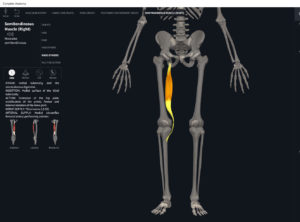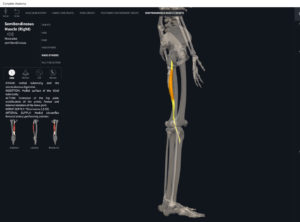Anatomy & Physiology: Muscles—Semitendinosus.
Structure.
- Origin: ischial tuberosity of pelvis, and part of the sacrotuberous ligament.
- Insertion: proximal aspect of the medial tibial condyle (pes anserine).
Function.
- Concentric action: accelerate knee flexion, hip extension, and tibial internal/medial rotation.
- Reverse mover action: posterior pelvic tilt; ipsilateral rotation and ipsilateral elevation of pelvis; thigh flexion, lateral rotation.
- Eccentric action: decelerates knee extension, hip flexion, and tibial external rotation.
- Isometric action: stabilization of the knee and lumbo-pelvic hip complex.
- Innervation: tibial nerve.
- Arterial supply: inferior gluteal artery, obturator artery.
Clinical Significance.
More.
- https://www.anatomynext.com/semitendinosus/
- https://www.physio-pedia.com/Semitendinosus
- https://www.youtube.com/watch?v=GYGrfF3gHEg
- http://orthopaedicprinciples.com/2018/05/anatomy-of-the-semitendinosus-muscle/
- https://stuart-hinds.com/blogs/performance-therapy/common-sports-injuries-treating-the-hamstrings
References
Biel, A. (2015). Trail guide to the body: A hands-on guide to locating muscles, bones and more.
Clark, M., Lucett, S., Sutton, B. G., & National Academy of Sports Medicine. (2014). NASM essentials of corrective exercise training. Burlington, MA: Jones & Bartlett Learning.
Jenkins, G., & Tortora, G. J. (2012). Anatomy and Physiology: From Science to Life, 3rd Edition International Stu. John Wiley & Sons.
Muscolino, J. E. (2017). The muscular system manual: The skeletal muscles of the human body.



